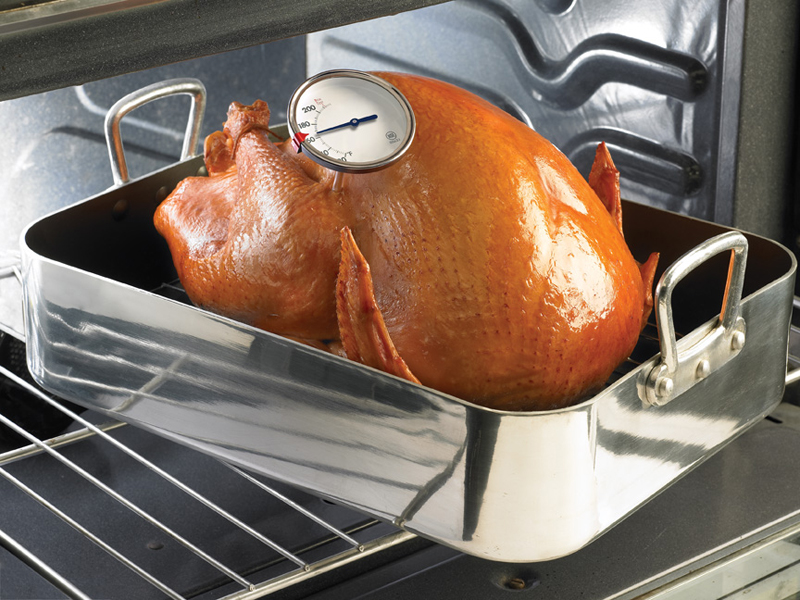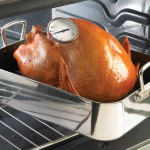
by Judy Corbus | Nov 27, 2015
 Have questions about safely preparing your holiday meal? Refer to this quick reference for answers to common questions this time of year:
Have questions about safely preparing your holiday meal? Refer to this quick reference for answers to common questions this time of year:
Q. Approximately how long should you allow for thawing a frozen turkey in the refrigerator?
A. 24 hours per each 4 – 5 pounds of turkey. In it’s original wrapper, place the frozen bird in the refrigerator (40˚F or below). To prevent cross contamination, be sure to place the turkey in a container. A thawed turkey can remain in the refrigerator for 1 – 2 days.
Q. How long should I cook the turkey?
A.
COOKING TIME – UNSTUFFED
Size of Turkey Estimated Time to Reach 165˚F
8 – 12 pounds 2 ¾ – 3 hours
12 – 14 pounds 3 – 3¾ hours
14 – 18 pounds 3 ¾ – 4 ¼ hours
18 – 20 pounds 4 ¼ – 4 ½ hours
20 – 24 pounds 4 ½ – 5 hours
COOKING TIME – STUFFED
Size of Turkey Estimated Time to Reach 165˚F
8 – 12 pounds 3 – 3 ½ hours
12 – 14 pounds 3 ½ – 4 hours
14 – 18 pounds 4 – 4 ¼ hours
18 – 20 pounds 4¼ – 4 ¾ hours
20 – 24 pounds 4 ¾ – 5 ¼ hours
Q. What is a safe internal temperature for cooking a whole turkey?
A. 165˚F. Use a food thermometer to check the internal temperature of the turkey. Insert the thermometer in the innermost part of the thigh and wing and the thickest part of the breast, making sure not to touch the bone. All turkey meat, including any that remains pink, is safe to eat as soon as all parts reach at least 165˚F. Let the turkey stand 20 minutes after removing from the oven. Remove any stuffing and carve the turkey.
Q. What is the recommended temperature for stuffing?
A. 165˚F. The stuffing should reach 165˚F whether cooked inside the bird or in a separate dish.
Q. I want to stuff the turkey. How do I do this safely?
A.
1. Cook any raw meat, poultry, or shellfish you plan to use before stuffing the turkey. Do not mix wet and dry ingredients until just before stuffing the turkey cavity; wet ingredients can be prepared ahead of time and refrigerated.
2. Spoon stuffing directly into the cavity right after preparation. Stuff loosely – plan for ¾ cup of stuffing per pound. The stuffing should be moist, not dry – bacteria is destroyed more quickly by heat in a moist environment. Do NOT stuff turkeys to be grilled, smoked, fried, or microwaved.
3. Cook the turkey immediately in an oven no lower than 325˚F.
4. Use a food thermometer to make sure the temperature of the turkey AND the center of the stuffing have reached a safe minimum internal temperature of 165˚F.
5. Let the cooked turkey rest for 20 minutes before removing the stuffing and carving.
Q. How long can I keep leftovers?
A. Refrigerate all leftovers within two hours after cooking. Divide cooked foods into shallow containers; this allows the center of the food to cool more quickly and evenly. Use within 3-4 days or freeze for longer storage. Be sure to reheat hot foods to at least 165˚F; sauces, soups, and gravies should be heated to a rolling boil.
For more information about holiday foods and food safety (in English and Spanish), call: USDA Meat and Poultry Hotline, 1-888-MPHotline (1-888-674-6854) www.fsis.usda.gov
Source: Avoid Guessing About Holiday Food Safety, University of Nebraska-Lincoln Extension.

by Judy Corbus | Jun 26, 2015

Photo Credit: Chris Luczkow, www.flickr.com
The bright, beautiful colors of a fireworks displays are a sight to behold and the highlight of July 4 celebrations across the country. But, it’s important to be careful when selecting and using fireworks for your family’s celebration. The National Council on Fireworks Safety offers these consumer safety tips:
- Check and obey local laws regarding what types of fireworks are legal in your area. Laws vary by state and municipality.
- Only buy consumer fireworks from a licensed store, tent, or stand. Never buy fireworks from an individual’s house or from someone on the street. Such devices are likely illegal explosives or professional 1.3G fireworks that can seriously injure you. Illegal explosives are often unpackaged and wrapped in brown paper. They are unlikely to have any safety warnings or the place of manufacture.
- Know your fireworks; read the cautionary labels and performance descriptions before igniting.
- A responsible adult should ALWAYS supervise fireworks activities. Never give fireworks to children.
- Do not consume alcohol while using fireworks.
- Wear safety glasses when shooting fireworks.
- Always have a bucket of water and charged water hose nearby.
- Light one firework at a time and then quickly move away.
- Use fireworks OUTDOORS in a clear area, away from buildings and vehicles.
- Never relight a “dud” firework. Wait 20 minutes and then soak it in a bucket of water.
- Never carry fireworks in your pocket or shoot them into metal or glass containers.
- Do not experiment with homemade fireworks.
- Dispose of spent fireworks by wetting them down and placing in a metal trash can away from any building or combustible materials until the next day.
- FAA regulations PROHIBIT the possession and transportation of fireworks in your checked baggage or carry-on luggage.
- Report illegal explosives, like M-80s, Quarter Sticks, and Cherry Bombs, to your local fire or police department.
Use your fireworks according to instructions and safety warnings and enjoy a safe, happy Fourth of July!
Source: National Council on Fireworks Safety, http://www.fireworksafety.com/
by Judy Corbus | Feb 14, 2015

Photo credit: IFAS Communication Services
Do you have a high school senior in your life in the near or not-so-near future? If so, it’s never too early to begin planning and preparing for the expenses associated with senior year. For starters, here are some typical expenses:
- Class ring – While this may be purchased during the sophomore or junior year, the cost can amount to several hundred dollars, depending on the material, design, and vendor.
- Senior pictures – Many photographers offer portrait packages featuring shots taken at off-site locations in addition to the traditional black drape and tux headshots for the yearbook.
- Yearbook – In addition to the average base price of $100, many schools offer ad space for purchase to mark your child’s special year. Prices can run from $25 for a quarter-page space to $200 for a full-page scrapbook-type ad.
- Class dues – Many schools charge students annual dues for various expenses associated with their particular grade level.
- Cap and gown rental, graduation announcements, thank-you cards
- Test fees – If your child will be taking the SAT, ACT, or other placement test, be prepared to shell out $50 or more per each test sitting. Prep classes will be an additional cost.
- College application fees – these generally run $35 or higher per school.
- Dances and Prom – Tickets, corsages, the dress, shoes, hair and makeup, tux rental, limousine rental, and dinner can add up quickly; the average cost of prom in 2014 was approximately $1,000.
- Class trip – Whether it’s a trip to a theme park or a white-water rafting adventure, factor in the costs of transportation, lodging, meals, admission tickets, and spending money for the excursion.
As you can see, senior year expenses can add up quickly! To ease the burden on the family budget, plan ahead. First, contact your child’s school for a list of anticipated expenses. Next, sit down with your high schooler and discuss the expenses he or she is likely to have. Decide together which are needs and which are wants – many items are “nice to have” but not necessary and there may be some items, like a class ring, that are of no interest to your child.
Set a realistic budget for the year and discuss ways in which your child can contribute through, say, babysitting or a part-time job. Explore alternatives to reduce costs – enlist a “shutterbug” friend to take photos, shop consignment stores for prom wear, print your own graduation announcements, purchase inexpensive thank-you cards. If your child is just starting high school, you can set up a special savings account now and contribute regularly so you are prepared when that time finally arrives.
With planning, senior year can be a very special and memorable time in your family’s life without breaking the budget. For more information on setting up a budget, contact your local UF/IFAS Extension Office or visit http://edis.ifas.ufl.edu/topic_budgeting.
Source: National Endowment for Financial Education, “Costs Heavy on Road to High School Graduation – Plan Ahead to Manage Expense of Child’s Senior Year’” http://www.nefe.org/press-room/news/senior-costs-2011.aspx
by Judy Corbus | Nov 21, 2014
 Do you have food containers growing green fuzzies in the back of your refrigerator? It’s easy for leftovers and other food items to overstay their welcome in the fridge, creating a food safety hazard as well as unnecessary clutter. With Thanksgiving and the start of the holiday season just around the corner, now is the perfect time to super-clean your refrigerator. Follow these tips to get your refrigerator ready for Thanksgiving leftovers and other holiday treats:
Do you have food containers growing green fuzzies in the back of your refrigerator? It’s easy for leftovers and other food items to overstay their welcome in the fridge, creating a food safety hazard as well as unnecessary clutter. With Thanksgiving and the start of the holiday season just around the corner, now is the perfect time to super-clean your refrigerator. Follow these tips to get your refrigerator ready for Thanksgiving leftovers and other holiday treats:
- Remove everything from the refrigerator.
- Examine each container – discard outdated leftovers and any items of whose age you are uncertain or you don’t plan to use in the near future.
- Remove shelves, drawers, and bins. Wash with a solution of baking soda and warm (not hot) water.
- Clean the interior of the refrigerator with baking soda and warm water. Dishwashing detergent can leave a residue that can lead to odors if not rinsed thoroughly. Dry with a soft cloth or paper towel.
- Clean each container before returning it to the refrigerator.
- Wash the outside of the refrigerator with sudsy water (using hand dishwashing detergent), rinse, and dry. Wash the gaskets around the refrigerator doors – sticky gaskets can cause air leaks, costing you more energy over time.
- Vacuum the dust off the condenser coils, usually on the back of the refrigerator, or under it. Dirty, dusty coils make the refrigerator work harder to cool and use more energy, costing you more money.
- Remove and clean the “pan” or plastic tray at the very bottom of the refrigerator that collects the condensation or defrost water. Look in your care manual to find where this “pan” is located. Dust and moisture in this “pan” can cause mold to grow, causing health problems for people with allergies.
- Clean the floor around and underneath the refrigerator.
Your fridge is now ready for the holidays!
Sources: My Florida Home Book – Taking Care of Your Home, Chapter 5. Taking Care of Indoor Features, University of Florida/IFAS Extension, 2008.
http://www.cooksinfo.com/clean-out-your-refrigerator-day
by Judy Corbus | Jun 27, 2014
 “Whew, I’m thirsty!” As temperatures rise, you may be saying that more frequently and for good reason. Better than one-half of our body weight is water and we lose water daily in sweat, urine, and feces. Water converts food into energy, regulates our body temperature, protects and cushions vital organs, and promotes regular bowel movements. In hot weather and during physical activity, it is easy to become dehydrated if we lose more water than we consume. Symptoms of dehydration include: difficulty swallowing, dry mouth due to low saliva production, headaches, fatigue, loss of appetite, dry eyes, muscle cramps, and kidney stones.
“Whew, I’m thirsty!” As temperatures rise, you may be saying that more frequently and for good reason. Better than one-half of our body weight is water and we lose water daily in sweat, urine, and feces. Water converts food into energy, regulates our body temperature, protects and cushions vital organs, and promotes regular bowel movements. In hot weather and during physical activity, it is easy to become dehydrated if we lose more water than we consume. Symptoms of dehydration include: difficulty swallowing, dry mouth due to low saliva production, headaches, fatigue, loss of appetite, dry eyes, muscle cramps, and kidney stones.
Most persons need six to eight cups of fluid every day. If you are eating high-fiber foods or taking a fiber supplement, taking certain medications, especially diuretics or “water pills,” engaging in vigorous physical activity, or the weather is hot and humid, you will need to increase your fluid intake. One-third of healthy persons 65 years or older have mild dehydration. If you have a senior adult in your life, encourage them to drink plenty of fluids to stay hydrated.
In addition to water, include these beverages regularly:
- Fruit juices – 100 percent juice, not a juice drink, which has added sugar. Six fluid ounces a day is enough.
- Low-sodium vegetable juices
- Low-fat or fat-free milk
- Vegetable or milk-based soups
Here are a few tips for adding more fluids:
- Start the day with a cup of water.
- Drink a cup of water about ½ hour before meals.
- Drink a full glass of water with your medications. This is best for most medications, but check with your pharmacist.
- Drink water before heading outdoors for yardwork or recreation. Thirst indicates fluid loss so drink before you feel thirsty. Take frequent water breaks during outdoor activity, especially in heat and high humidity. Drink one to two cups, or more if needed, of water during and after being outdoors.
- Fill a water bottle and carry it with your during the day.
- Eat “juicy” fruits, such as watermelon, peaches, cantaloupe, and honeydew. Chill for a refreshing treat.
What about sports drinks? Sports drinks contain water, sugar for energy, and electrolytes, including sodium, to replace those lost through perspiration. They promote fluid retention and tend to encourage fluid intake because of their taste. They are highly recommended during intense physical activities that last over one hour. For casual activities of less than an hour, water is a good choice for hydration. Be aware that beverages high in sugar, including fruit juices, can cause nausea or gastrointestinal distress. Caffeine or alcohol increase urine output and reduce fluid retention. Carbonated beverages can make you feel full, decreasing the amount of fluid you drink.
So stay hydrated this summer with healthy fluid choices to beat the heat!
Sources: Healthy Eating: Fluids
Casa, D.J., et al. Fluid Replacement for Athletes Journal of Athletic Training. 2000; 35(2): 212224.

 Have questions about safely preparing your holiday meal? Refer to this quick reference for answers to common questions this time of year:
Have questions about safely preparing your holiday meal? Refer to this quick reference for answers to common questions this time of year:




